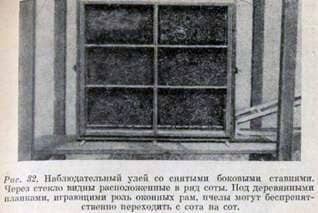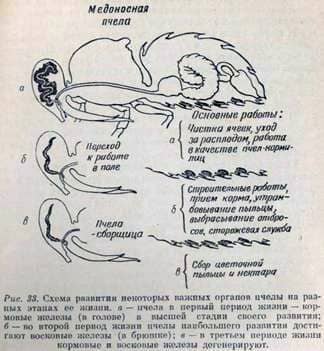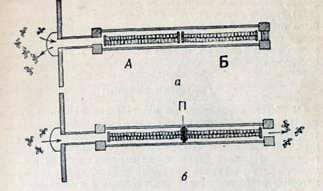
We have already said that in the bee family there is a distribution of work. Some care for cleanliness, others look after the brood, build honeycombs or get food. Some researchers try to draw an analogy with the distribution of labor in human society and recall hairdressers, nannies, sculptors and farmers. However, one can not fail to notice a significant difference: a person who devotes himself to a profession, is engaged in it, as a rule, until the end of life. Working bees have a habit, depending on their age, to change their occupation many times.
In order to explore this in more detail and trace the life path of individual individuals, selecting them from the mass of companions for the hive, one must stock up not only with patience, but also with some technical equipment.
Observational hive and tagged bees

The bee hive is a dark box. To see its inhabitants, we need to use an observation beehive in which honeycombs are not located in the usual order, one after another (see Figure 5.), and one next to the other, so that through the glass you can observe all the Actions of the bees. To make it easier to recognize the bees whose life path we want to track, they should be noted, it is best to number. This can be done with the help of aniline paints, which dissolve in an alcohol-alkaline solvent.
A white spot on the anterior dorsal part of the bee’s breast signifies the number 1, red on the same bridge-2, blue-3, yellow-4, green-5. The same colors at the posterior end of the breast have the following values: white – 6, red – 7 , blue – 8, yellow – 9 and green – 0. By means of corresponding combinations of two spots, we can now write double figures. For example, white – red on the front of the breast = 12, red on the left in front and yellow on the right behind = 29, and so on.
Colored spots on the abdomen denote hundreds. Thus, with the help of five colors, we can reach the designation 599, and if necessary, expand the boundaries of such a system even more. The advantage of this method is that with some skill, color marks are as easy to read as real numbers, and glowing colored specks can be distinguished from afar even on flying bees.
The results of long-term observations using this method will be briefly described below.
Activity of bees in different periods of their life
The life of a worker’s bee from birth to death can be divided into three periods.
In the first period of life (approximately from the first to the tenth day) the bee works inside the hive and is called a beehive hive. It can be seen creeping forward the head into the cells released after hatching from them other bees. It cleans and treats the internal walls of the jaws with jaws. The meaning of the latter action is not yet known, but it is fairly established that the uterus lays eggs only in cells so treated. By protecting cells with brood from cooling, young bees spend most of the time usually in inactivity, staying on the honeycomb without movement or slowly walking along them. In the future, we learn that even with this inaction they contribute to the overall well-being of the family.
In a few days in the head of the bee fully develop those very fodder glands. From this time, the bee can be considered ripe for the fulfillment of the main task of the first period of her life – working as a wet nurse. Protein substances for the development of fodder glands come from pearl stocks, which are absorbed and digested in large numbers by bees-nurses producing “royal jelly.”
Caring for a child is a lot of trouble. To grow a single larva, the bees that care for her have to look into the cell two or three thousand times. If we calculate how much time it takes for one bee-breadwinner, it turns out that for all the time during which she fulfills the duties of “babysitting,” she can only grow two or three larvae.
By the end of this period of life, the bee leaves the hive for the first time and rushes into the orienting flight. After about five minutes, she’s home again. But during this time, she looked around and captured the area in her memory. If it is caught and taken to the side, it will find its way home from a distance of several hundred meters from the hive.
In further orienting flights, the bee improves its acquaintance with the terrain; now she can already go on to perform duties related to staying outside the hive.

In the second period of life (approximately from the tenth to the twentieth day) the bee glands of the bee degenerate and its work as a wet nurse ends. But by this time the wax glands – the basis of its construction activity – have reached the highest development. Another task of the bee of this age is to take and process the nectar brought to the hive, fill the cells with it, or crush the jaws and compact the renewals dropped by the bee-pickers into the cells.
Cleanliness must be maintained in the hive, but this work is connected with going free. Bees pick up all sorts of garbage, and often the bodies of lost comrades in the hive and, flying off with them for some distance, drop their burden.
A person who has come too close to the apiary without any malicious intent may unexpectedly be attacked by bees. Of course, he does not know that he is attacked by bees of a very definite and severely limited age who are fulfilling their duty, obeying tradition and an unwritten law: at the end of the second period of life, they are, as far as necessary, guarding the gate. Carefully probing the mustache of all incoming bees, protecting the dwelling from wasps and other honey robbers, they instantly rush to attack if a person, horse or other monster comes too close to their settlement.
The sting of a bee is supplied with small notches, and therefore, stinging, it can no longer extract it from the skin of the enemy. The bee tears it out together with a part of the guts of the abdomen and dies.
In the third period of life (approximately from the twentieth day until death), the bee becomes a picker.
She flies out for a bribe to bring a nectar and pollen of flowers to the hive. In bad weather, preventing the flight, bees – pickers reluctantly return to domestic affairs and perform them extremely carelessly. For the most part, they just wait for better times. The saying about “diligence” of bees arose because people usually see only bees taking bribes. If you observe the inner life of the hive, you can very soon see that the bees are lazy for a long time.
Age of bees
The reader has the right to expect that the bee, who entered the last period of his life, will have many weeks of flights to the flowers for a bribe. But this is not so. The bee life is short and the working bee, which began to collect nectar and pollen, has lived more than half the life. In spring and summer, it is rare to see worker bees older than four to five weeks, counting from the moment they hatch from the cells. Many are killed even earlier, colliding during flights for a bribe with many dangers. The fact that this period is at the end of all the activity of the bee has a profound meaning.
The situation is different with bees, which are taken out at the end of summer or in autumn. In the winter there are no flowers, and consequently, sources of food for brood rearing. The uterus stops egg production for many months, and there is no increase in the family at that time. If the working bees lived only a few weeks in winter, the family would soon be extinct. The problem is solved simply: the age of the winter bees reaches many months, since in the fall they can fatten up the stored pollen, and the reserves accumulated in their body are not wasted, because during this period the family does not grow more brood. Eating well and being in a state of “quiet contemplation,” they spend the winter. When spring approaches and the uterus resumed egg laying, the worker’s bees still have a fat body, and thanks to well-developed stern glands they are ready to care for the brood.
The uterus lives the longest, able to fulfill its maternal duties up to four to five years.
However, this is not an absurd cruelty of nature, as some think. On the contrary, there is common sense in this. In the detached rear of the intestines there is a nerve node that controls the action of the sting, as well as a poisonous gland, the connection of which with the sting is not disturbed. Thus, the stinging apparatus turns out to be separated from the bee, but alive. If the stinger is not immediately pulled out, then for some time the poison will be pumped into the wound and serve as an effective weapon against an enemy superior to a bee in strength. To the numerous bee state, the loss of several infertile females does not cause appreciable damage. Significantly more often the sting is applied against individuals of the same species or other insects. It is easily removed from their solid chitinous cover, in which it is not held as firmly as in the elastic skin.
Unsuccessful attempt to interfere with the order of life of the bee family.
The cycle of work carried out by a bee during her life, apparently, is directly dependent on her physical condition. She becomes a wet nurse when her fodder glands fully develop; she turns to other studies, as soon as these glands degenerate and the allocation of “royal jelly” stops; she becomes a builder when her wax glands reach the apex of their development. Is the development of organs really conditioned by definite periods a motivation for the development of instinct? Will their sequence remain unchanged even if several needs arise in the bee family?

Fig. 34 Turning observation beehive to divide the bee family into young and old bees (horizontal longitudinal section at the height of the tap).
To solve these issues, a small bee family was placed in an observation hive with two honeycombs (A and B) and two tapholes, one of which was initially closed. Within eight weeks, over a thousand newly hatched bees were numbered. Thus, their age was precisely known. Once all the bees that were on cell B were driven to cell A. Then a prefabricated partition (77) was set up between the two honeycombs, the hive was rotated 180 њ and the second tray was opened.
Young, not yet departing bees remained, of course, on cell A; The flying bees left the beehive in the next afternoon hours and returned home in the usual way, which led them to a hundred b. Thus, the division of the family into a “young” in branch A and “old” on cell B. was completed. There were no beekeepers in a young family. There was no one who could get food, and his insignificant supplies were quickly consumed. Two days later we saw a sad picture: a part of the bees lay on the floor, dying of hunger, some larvae were pulled out of their cells and sucked.
On the third day there was a striking change. Despite all the customs for a bribe flew bees that have reached just a week or two weeks of age, and returned home with a burden. Thanks to the fully developed fodder glands, they would have to become bees-nurses. But not their physical condition, but the needs of the family proved to be a decisive condition; for a few days their glands contracted and fatigued. At that time in the family with old bees there were not enough bees-nurses. This gap was filled by those bees that were still relatively young, in these bees the full development of the feeding glands lasted much longer than usual.
In another family, by a similar intervention, most of the bees-builders were selected, and the family was placed in such a position that the construction of new honeycombs proved to be extremely necessary. And honeycombs were built.
Harmony of work.
Under normal conditions, there can not be such a sharp disruption of the order of life, as in the experiments described above. But the needs of the family, although to a lesser extent, are still very variable. In a beehive there is more, then less hungry bee babes; After a period of bad weather, copious bribes may immediately begin to occur, for the development of which sharply increases the need for bees-gatherers. With rich honey, you need a lot of empty cells to fold the nectar delivered to the hive, and as a result, the need for wax and new honeycombs from day to day will become more acute.
These fluctuating needs are met in the bee family due to the fact that the development of fodder and wax glands does not occur strictly according to the scheme indicated in Figure 33, but with known deviations. In addition to bees, for which it was the turn to perform some specific work, there are also other bees in the family, always ready to help if necessary.
In one part of these bees, somewhat earlier than is usually observed on average in bees, the gland develops, while the other has waxing excretory organs, and the tendency to perform a particular job is less consistent with the generally accepted calendar of work than with the requirements of the moment. To take these demands into account is the task of loafers, seemingly aimlessly loafing about the honeycombs. They keep an eye on everything that is happening, put their heads in those and then in other cells and are taken for any business, if only they notice gaps in the work. Thus, labor in a bee family is largely due to lazy people with its harmony. Inactivity can be justified, unless it becomes the basic life principle.
Пчелы в зиму корма. Рулет с грецкими орехами и медом.
The bee family and its composition